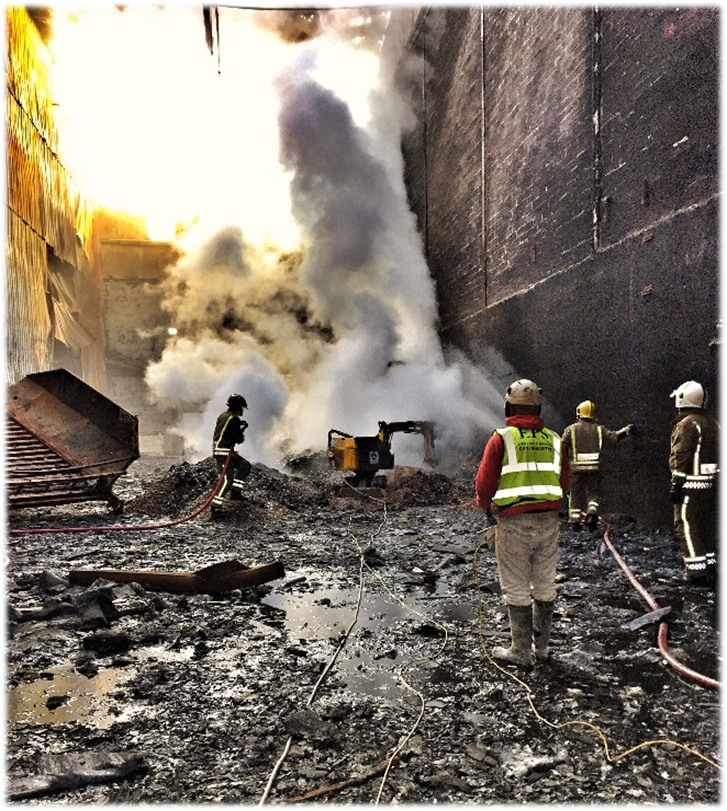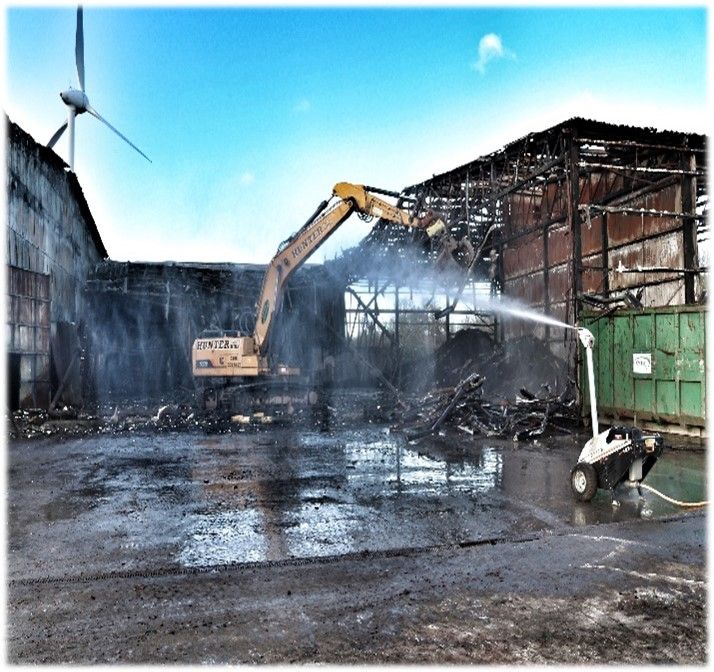A fire blazed in a recycling and composting facility located at Sharpness docks, Gloucestershire for 9 months causing significant damage, disturbance and distress to people and the environment.
Prior to our involvement, there was considerable strain between the land-owners, local authority (Stroud District Council), the Environment Agency and the general public; a significant number of complaints were made regarding the smell, smoke and dust arising as a result of the fire. The combustible nature of the compost material involved meant that the fire was self-sustaining, and that the conventional fire-fighting techniques of introducing water caused an exothermic reaction refuelling the fire. The situation was further complicated by the building being condemned as unsafe for access and comprising significant proportions of hazardous materials. When we were instructed, the fire was still raging and had consumed much of the facility, including the structure, the plant, equipment and compost like output (CLO) which was stored inside.
Sanctus took part in a public consultation with the relevant stakeholders, acting on behalf of the Canal and River’s Trust as consultant and principal contractor; we quickly developed an innovative solution to addressing the ongoing problem, utilising robotic equipment to extinguish the fire.

Sanctus utilised a Brokk excavator, remotely controlled to remove burning waste and reduce the potential for waste fuelling the fire, by spreading the CLO across the floor of the facility to aid cooling and treat the fire in manageable sections. The Brokk enabled minor demolition activities to be undertaken to make the area safe, without operatives needing to enter the building, reducing the risk of exposure to smoke, fire and falling debris. This use of specialist equipment allowed firefighters to control and ultimately extinguish the fire safely and more effectively; enabling the fire to be extinguished within two days.
We also provided an emergency site presence and worked alongside the Fire Brigade to provide advice on asbestos containing materials and hazardous waste which was burning inside the facility. Our priority was to avoid risk to people operating in the vicinity of the fire, ensure their health, safety and wellbeing and protect against impacts on the wider environment.

Innovative Thinking and Exemplary Best Practice
Following the cessation of the fire, Sanctus deployed a drone to inspect and assess the extent of the fire damage, including surveying the facility roof, which was constructed from cement bonded asbestos sheeting. The aerial inspection demonstrated that the roof was severely damaged, and posed a high risk of collapse and significant risk to health, safety and wellbeing. Based upon the asbestos type, volume and current state, the works were classified as NNLW (notifiable, non-licensed works) and conducted in line with our exemplary processes and procedures.
We developed a detailed Plan of Works to dismantle and demolish the asbestos roof structure in the safest possible manner, outlining the control measures required in accordance with HSE best practice guidance.
The site was set up for works with asbestos. This included the deployment of decontamination facilities, a perimeter dust suppression system, with clear segregation of works areas.
The asbestos containing material was dampened using Motofog and dust suppression equipment. A long-reach telehandler was positioned outside the building and used to gather the asbestos debris remotely. This approach removed the risk of entering the unsafe structure and eliminated the potential for exposure to asbestos to site workers.
Following the removal of the asbestos roofing and debris from the slab, Sanctus undertook a soft strip demolition of the building fabric within the offices and welfare block adjacent to the warehousing. Sanctus then completed the controlled demolition of the remainder of the building using demolition-spec excavators, mobile elevated working platforms and cutting equipment.
The cleanliness and organisation achieved on site was such that it was later used as an example of the dust suppression manufacturers’ equipment, for use in their official advertisement on their website and social media channels.

Air pumps were deployed around the site boundaries and during specific works activities to determine any potential for fibre release. Samples were taken and analysed by an independent UKAS accredited consultant in a mobile laboratory. The control limit of 0.1f/ml was never exceeded, which indicated that the dust suppression control measures deployed to eliminate airborne asbestos fibres were highly effective.
Cost Effectiveness
Sanctus’ extensive contracting experience, knowledge of waste classification, commitment to sustainable recovery and use of materials informed our approach to the restoration of the site.
The combination of materials meant that we had to consult with the Environment Agency, and establish an innovative ‘problematic waste’ stream designation to allow processing and disposal, not only saving the public purse millions of pounds in the cost of the specialist bulk incineration, but saving the client considerable time, and avoiding any potential unnecessary negative publicity.
We successfully identified a number of different waste streams at the site. As a result of the material produced at the facility, the fire damage and the subsequent demolition of the structure each presented different challenges. Each waste stream was therefore segregated at source, and a suitable facility identified which could accept the material, in accordance with the waste hierarchy. Where possible, material was sent the shortest distance to reduce the impact on the local infrastructure, the carbon footprint of the works and overall environment impact.
The CLO was sent to a local restoration site for landscaping purposes; LECA (light expanding clay pellets) and general waste was removed from site for recycling at the nearest economical viable facility. Asbestos containing materials including cement-bonded sheeting were segregated under controlled conditions, loaded into sealed skips and removed from site to a licensed disposal facility. Waste oil and water were sent to a neighbouring facility for treatment and recycling.
Hydrocarbon contaminated materials, including concrete, and the impacted underlying soils were sent to treatment centres. Metals – both ferrous and non-ferrous, found as part of the facility structure were cut into smaller sections and removed for recycling using a local facility in Sharpness. Wood based material, and plastics found as part of the facility structure were segregated and sent for recycling.
Difficult (burnt) waste – both CLO, asbestos containing materials and structural materials which had no potential for treatment or re-use were the only materials sent to landfill significantly reducing further impact on the environment.
Following the demolition of the structure and some areas of the ground slab, clean hardcore material was recovered from the process and transported to a local visitor attraction, for reuse as a sub base for new access roads- demonstrating our commitment to the circular economy.
Compliance with Legislation, Codes & Guidance
During demolition work, a number of trenches, totalling over 200 linear metres were identified within the concrete slab. These interconnected with sub-surface underground oil storage tanks, which were not detailed on existing site plans, recorded or registered. Sanctus consulted with the Environment Agency and Local Authority; the client’s tenant at the site held an Environmental Permit for the recycling and composting operations, which was required to be surrendered. In order to facilitate the surrender of the permit and to ensure the site was not listed under Part 2A of the Environmental Protection Act 1990 as Contaminated Land, further site investigation, and remediation was required.
Sanctus was instructed to undertake a Phase 1 Contaminated Land Desk Study and a Phase 2 Site Investigation on the site. The Phase 1 study included a review of historical maps of the area dating back to 1881; environmental information collected from regulatory bodies and national agencies; and geological, hydrogeological and hydrological information.
The targeted Phase 2 intrusive site investigation was planned to allow the characterisation of the site’s subsurface, and the position of the trenches and associated tanks. The SI comprised 20 trial pits excavated with a 13t tracked excavator, and the advancement of 6No boreholes undertaken using cable percussion techniques; two of which were selected to install groundwater monitoring wells to a depth of 6.0m bgl. Selected soil and water samples were sent to an independent MCERTS and UKAS accredited laboratory for chemical testing, with soil samples being compared against two criteria; Natural Background Concentrations of the soils from BGS data; and Generic Assessment Criteria for an industrial/commercial land use scenario. Dataloggers placed in the boreholes provided evidence that the groundwater at the site was not tidally influenced by the nearby Severn Estuary.
Based upon the data obtained from the site investigation, Sanctus undertook a qualitative risk assessment and revised the conceptual site model. We concluded that the exceedances of petroleum hydrocarbon and metal concentrations were as a result of the operations undertaken at the site, with a moderate risk to controlled waters and that should piled foundations or deep services be required, the risk could grow We therefore produced a remediation strategy for the site. Excavation was undertaken in order to remove petroleum hydrocarbon impacted soils and contaminated perched waters. The excavation was extended due to the presence of visually impacted soils being encountered and ceased when no visual / olfactory evidence of contamination was identified.
The contents of the main underground tank were removed via pumping, and the tank was decommissioned by cleaning and later by filling with resin to enable it to be left in situ, on site but in a state so as not to pose any ongoing liability.
As part of the remediation strategy soil validation samples were obtained from faces and bases of the remedial hotspot excavation and compared with the soil remediation target criteria. Samples were sent to an independent MCERTS and UKAS accredited laboratory for chemical testing. 12 samples were analysed to determine that the contamination source had been suitably removed.
The contaminated concrete hardstanding, hydrocarbon impacted soils and impacted perched waters were removed from site by licenced waste carriers to suitably permitted facilities, under Sanctus’ duty of care in accordance with the Waste Regulations.
All excavated trenches were backfilled and levelled using local quarried stone to again reduce the environmental impact of our works.
Public/Stakeholder Engagement
This site was hugely problematic for the community, the environment, the Local authority and the Environment Agency. Almost daily complaints were received for in excess of 9 months due to odour, flies and emissions from the fire. The situation became so challenging that tensions began to develop between the respective authorities.
We believe our work should benefit people and the environment so prioritised working with partners to meet the local community within their community to understand their views. We therefore jointly held a community engagement event at the “Dockers Club” and listened to the understandable frustrated community.
This information helped inform our planning and communication with residents, through the respective authority as we began the process of work on site.
Following our involvement and the successful extinguishing of the fire, no further complaints were ever received about this site, instead we achieved a huge amount of positive feedback including the below feedback from project partners.
Project Management Team – Watts Group Limited – “I am pleased to say that I was happy on all counts. I would not hesitate to use Sanctus on any future schemes.”
Estates Management Group – Ashville Group – “It was a pleasure to work with Sanctus. For what was a complicated project, on the ground and in the board room, Sanctus were thoroughly professional and helpful throughout.”
Economic, Environmental and Social Benefit
Our innovative approach to observation, access, demolition, environment monitoring and management solved an environment crisis for the community in Sharpness and did so at a fraction of the potential cost.
Our experience and knowledge of engineering, waste and environmental issues meant we were uniquely placed to solve this multifunction puzzle.
The final requirement of the siteworks was to make safe the existing substation which fed the former facility. Sanctus installed tamper-proof fencing with a small easement around the substation, and left the site safe and secure, ready for future development.
What once was an impossible problem was now a site ready for a brighter future.
